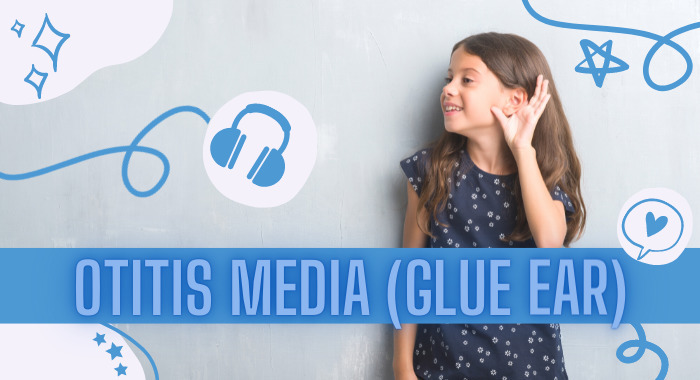What is Glue ear?
Glue ear happens when the middle ear (the space behind the ear drum) is filled with fluid. The fluid can be thick and sticky, like glue. That's why it is called glue ear. Glue ear can affect one or both ears. It often follows an ear infection or can happen on its own. After an ear infection, the fluid in the middle ear may stay around for weeks. This can happen even if your child has had antibiotics. The fluid clears up in 8 out of 10 children within 12 weeks. When there is still fluid for more than a couple of weeks, this is called glue ear.
What is the cause?
There are many causes including colds, allergies, post viral infections, enlarged adenoids, a middle ear infection, laying babies down during or immediately after feeding (which allows fluid to flow up the eustachian tube to the middle ear) and air travel when you have a stuffy nose or cold.
Does it affect children’s hearing?
YES! Depending on how much fluid is in the middle ear cavity. The middle ear is normally filled with air that allows the ear drum to move and transmit sound waves to the inner ear. If the fluid in the middle ear gets thick and sticky, hearing is more impaired. Children may have mild to moderate hearing loss.
It sounds like listening to the radio just off the station - the sound is distorted, it is harder to hear and hearing can be inconsistent.
Yes it can. If speech is not heard clearly, it cannot be repeated clearly. Yes it can be. With the added background noise in a classroom, it can be frustrating and challenging for children with a hearing loss. Poor behaviour and listening can be the result.
A full investigation by your doctor and an Ear Nose and Throat Specialist should determine the cause of the fluid build up. To do this they will use:
- an instrument called an otoscope to look at your child's ear canal and ear drum - an otoscope contains both a small powerful light and a low power magnifying lens
- and sometimes, tympanometry
Tympanometry is a test which uses a device to find out how well the ear drum moves back and forth. If there is fluid in the middle ear, the ear drum does not move. Tympanometry is not a hearing test and a 'pass' on this test does not necessarily mean that your child can hear well - it just means that it is unlikely they have glue ear at the time of the test. Sometimes, your doctor may recommend a hearing test for your child.
What is the treatment for Glue Ear?
The best treatment for glue ear is time. In most children, episodes of glue ear get better without treatment. For this reason, your family doctor may simply recommend regular checkups for up to 3 months so they can examine your child's ears. If your child has fluid in the middle ear for more than 3 months, there are some treatment options. Some children with Glue eat may requrie ventialtion tubes (or grommets) to aid with the draining of fluid.
Some signs to look for in your child.
- A speech delay or changing speech ability
- Does not hear when called from another room or in background noise.
- Likes the television turned up and/or hates sudden loud noise.
- Watches your faces for visual clues and/or forgets instructions.
- Either shouts or whispers (can’t monitor own voice level).
- Has poor concentration/is distracted; is tired and/or a poor sleeper.
- Has two ear aches in a short period of time and requires antibiotics.
- Inconsistent hearing due to fluctuating fluid.
- Have your child’s hearing tested every six to 12 months throughout childhood, with particular attention to tympanometry (middle ear testing).
- Get your child’s attention before speaking to make sure that he/she is listening. Remind your child to listen when necessary.
- Whenever possible get down to your child’s level to talk. Getting close (no more than one metre away) and facing the child will help you to provide clear visual and auditory information.
- Speak clearly and repeat important words, but use a natural speaking pattern.
- Make important information stand out by emphasising with intonation and stress and repeating when necessary.
- When possible, use visual support to help your child understand what they are hearing. For young children, you might point to objects, pictures or people when you talk about them. For older children, you might give written as well as verbal instructions.
- Seat your child close to the speaker but where your child can also see other children(e.g. at the side of the room).
- Be responsive by showing an interest in and talking about things that interest your child. Respond immediately and consistently to your child’s initiations.
- Reduce distractions by using movable barriers (i.e. bookshelves, flannel boards) to create small areas in a room where small group and one-on-one interactions can take place.
- Making the listening environment less noisy by hanging washable draperies over windows, closing doors and minimising noise from appliances (e.g. air conditioners, fans, vacuum cleaners, television) makes it easier to hear language.
- Be aware that increases in distractibility, irritability, ignoring behaviour or absence/reduction in sound-making may be signs of middle ear problems.
If you suspect your child may have glue ear contact your nearest Child and Family Health Centre or talk to your public Health nurse. The best intervention is early intervention.
Published by - Anna Keno, Speech & Language Therapist (BSLT, MNZSTA)


